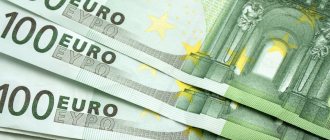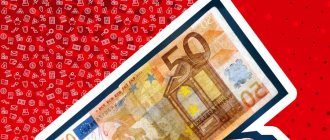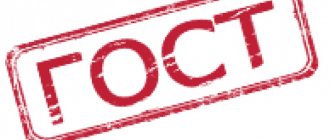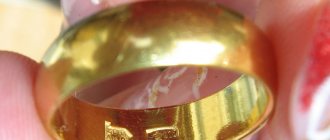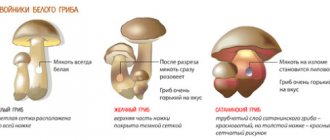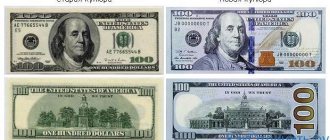What euros are in circulation?
Currently in use are 5, 10, 20, 50, 100, 200 and 500 €. They are designed according to the same standard. The front side contains the word euro
, year of issue, signature of the president, security elements, denomination, flag, twelve stars.
Interesting materials:
When will the new Duster come to Russia? When did Vladivostok become Russian? When will flights from Germany to Russia resume? When will the Russian Premier League resume? When will the Russian football championship resume? When did the Russian tricolor first appear? When does the Law of the Russian Federation come into force? When were new numbers introduced in Russia? When was Oge introduced in Russia? When are the elections to the State Duma of Russia?
Appearance
Each euro bill has a specific size, motif and main background color. These signs do not relate to security measures, but are the first factor by which these banknotes can be distinguished. The features of Euro banknotes are as follows:
- 5 euros. The main background is gray, the motif is the classical era, parameters are 120x62 mm.
- 10 euros. The bill is made in red and burgundy tones, Romanesque era, dimensions - 127x67mm.
- 20 euros. The predominant shade is blue, the motif is Gothic architecture, the dimensions are 133x72 mm.
- 50 euros. The background color is orange-brown, the motif is Renaissance, dimensions are 140x77 mm.
- 100 euro. The banknote is made in dark green tones, Rococo and Baroque styles, parameters - 147-82 mm.
- 200 euros. The dominant color is yellow, the motif is the era of industrialization, dimensions are 153x82 mm.
- 500 Euro. Main color - purple, 20th century architecture, dimensions - 160x82 mm.
Where to look for marked goods
It is more convenient for buyers to come to a retail outlet, knowing in advance that there they will find a 100% original brand without the risk of getting caught by fakes, replicas or outright counterfeits. However, the app does not yet offer such a card to consumers, as this would legally discriminate against other stores. Perhaps in the future, when the pilot project receives more market participants, this function will be implemented.
So far, only individual stores display a corresponding sign on their windows or websites, which can tell that they sell original products. Taking into account the growing popularity of verification through the corresponding service, this fact is a competitive advantage that they did not fail to take advantage of. Again, widespread publicity that a brand can be purchased at a particular point, but not at others, will violate the legal rights of market participants. The Government has not yet regulated this issue in any way due to the fact that a small part of circulating products is subject to mandatory labeling.
Country code and cliche
Only national central banks of European countries have the right to print banknotes and produce coins. In this matter, their actions are subordinate to the Central Bank - the ECB. The ECB Council decides on the need for additional emissions. The council must include representatives of EU national banks.
The place of manufacture will be determined by each state independently. These may be their own printing houses or organized production in another country. The denominations of Euro banknotes, photos of which refer to different countries, have corresponding numbers. It is by the first letter in the number that you can determine the country of issue of any banknote. A specific issuer is identified by a checksum that performs the function of protecting against counterfeiting.
So, L is for Finland, M is for Portugal, S is for Italy, etc. The country of Luxembourg does not have its own letter because it does not issue cash.
The cliche number consists of 6 characters, containing information about the printing house where the money was printed. The code never coincides with the country number and is decrypted as follows:
- the letter defines the typography;
- the three subsequent digits indicate the number of the printing plate;
- the fifth letter symbol means a row on the cliche;
- The sixth digit is the number of the column where the bill is placed on the cliche.
In Europe, private enterprises operate along with state printing houses. They operate on the basis of a license. Thus, in Germany, cash production is carried out by printing houses located in both the eastern and western regions. In France there is a state-owned enterprise and a private printing company.
How to check the authenticity of euros by number and main security features
During the existence of the currency, two series of banknotes were issued. The first issue was in 2002, in 2013 the banknotes were updated, the series was called “Europe”
.
Read also: Definition of mission. Setting goals
When checking the authenticity of euros, you should pay special attention to the paper. For printing, special paper with a cotton base is used, which makes the banknotes durable and thin. The fakes will be an order of magnitude thicker and softer. In addition, if you bend real Euros, they will create a characteristic crunch. You can also check the authenticity of euros by the properties of the paper using UV light. It will not have the background glow characteristic of a regular one.
Serial number
Check the serial number of the bill located on the back of it. It consists of a letter of the Latin alphabet and 11 numbers.
On EU money, the letters are always smaller than the numbers.
Sum up all the numbers on the euro banknote identifier, and then add to the result the serial number of the letter in the alphabet - if the 100 euros are genuine, issued by the ECB, then you should get 8. As an example, you can take the number S13136902855. Adding all the numbers, we get 43 (1 + 3 + 1 + 3 + 6 + 9 + 0 + 2 + 8 + 5 + 5 = 43).
Each letter has a corresponding code - check digit . On a genuine banknote, the sum of the digits of the serial number and the check digit are the same. After this, we add to the result the serial number of the letter S, equal to 19: 43 + 19 = 62. We sum up 6 and 2, we get 8. This number indicates the authenticity of the bill.
| Serial number letters in the alphabet | Letter code | A country | Check digit |
| 4 | D | Estonia | 4 |
| 5 | E | Slovakia | 3 |
| 6 | F | Malta | 2 |
| 7 | G | Cyprus | 1 |
| 8 | H | Slovenia | 9 |
| 10 | J | Great Britain | 7 |
| 11 | K | Sweden | 6 |
| 12 | L | Finland | 5 |
| 13 | M | Portugal | 4 |
| 14 | N | Austria | 3 |
| 16 | P | Netherlands | 1 |
| 18 | R | Luxembourg | 8 |
| 19 | S | Italy | 7 |
| 20 | T | Ireland | 6 |
| 21 | U | France | 5 |
| 22 | V | Spain | 4 |
| 23 | W | Denmark | 3 |
| 24 | X | Germany | 2 |
| 25 | Y | Greece | 1 |
| 26 | Z | Belgium | 9 |
There are many ways to distinguish 100 euros from a fake. But no matter what security methods the money is equipped with, counterfeiters are constantly improving their skills and finding new opportunities to counterfeit banknotes.
To avoid becoming the owner of counterfeit currency, you should only purchase it from a bank. People who buy euros secondhand run the risk of getting a counterfeit.
How to check the authenticity of a euro: checklist with photo
The euro banknote is one of the main targets of counterfeiters
How to check the authenticity of a euro Photo: https://leganerd.com/
Read also: Abdominal X-ray with barium
More than 20 years ago (January 1, 1999), the euro first entered non-cash circulation. And three years later - from January 1, 2002 - the new currency entered into cash circulation. Banknotes began to appear in Europeans' wallets. Today, 19 EU countries have switched to a single currency.
The problem of counterfeit banknotes continues to harm businesses and ordinary citizens year after year. In this review the editors of PaySpace Magazine will tell you how to check the authenticity of euros without having specific equipment at hand.
What do euro banknotes look like?
Before you check the authenticity of the euro, you need to know what European banknotes look like: what colors, sizes and images correspond to different banknote denominations. Then you will immediately recognize counterfeit euros with additional zeros on them.
Over the entire existence of the euro, the European Central Bank has issued 2 series of banknotes.
The first issue “Series 2002” has 7 banknote denominations: 5 €, 10 €, 20 €, 50 €, 100 €, 200 €, 500 €.
The second issue of the “Europe Series” so far contains only 4 denominations: 5€, 10€, 20€, 50€. The first banknotes of this series appeared in circulation in 2013.
How to check the euro: a quick way
If you need to determine whether euros are real or not, and you are short on time, limit yourself to a basic check.
- The banknote should be dense and rough to the touch thanks to the cotton paper
- Against the light, watermarks, a protective strip with the denomination of the banknote and elements of numbers that together form the denomination of the banknote appear on the banknote
- At an angle, some elements (hologram and golden stripe) will change color
How to check the authenticity of the euro: detailed examination
The security of euro banknotes is one of the most modern in the world. However, this does not stop counterfeiters. Let’s try to figure out what a genuine euro banknote should look like with all the security elements without exception, using the “Series 2002” banknotes as an example.
- Paper. Euros are printed on special cotton paper. This gives it rigidity and makes it “crunch” when bent. The front side of the banknote is smooth. And on the other hand, it’s rough.
- Seal. A special printing method makes the images appear in relief. By touch you can distinguish the main image, the abbreviation of the European Central Bank in five languages, the date of issue of the series, the sign and word “euro”, and the denomination of the banknote. All these elements are located on the obverse. The 200 and 500 euro banknotes also have special serifs for people with low vision.
- Water marks . Due to the different thicknesses of banknote paper, images and numbers are visible when holding the banknote up to light. They are visible on both the obverse and the reverse.
- Mosaic. In normal lighting, there are elements of numbers on the euro, but if you look at the bill against the light, the denomination of the banknote will be visible on both sides thanks to invisible lines
Security tape and thread on the 20 euro banknote
- The security thread is located in the thickness of the paper and is visible through the light. It bears the denomination of the banknote and the word euro.
- The security strip is visible at an angle, has a pearl-golden color and displays the denomination of the banknote (used for 5,10 and 20 euros)
- Microtext is noticeable when examining in detail the inscriptions and stripes printed on the banknote, for example, on the EYPO element (euro in Greek) and on architectural ensembles.
Microtext on the 50 euro banknote Photo: effektivo.eu
- Ultraviolet light makes only some elements of the banknote glow - veins of red, blue and green colors in the thickness of the paper, the green and orange flag of the European Union, the signature of the head of the ECB, the stars and the ring on the front side of the banknote. The card, bridges and denomination on the reverse side glow yellow. However, the color of the paper itself does not change.
- Infrared light makes part of the image invisible.
- The hologram for 50, 100, 200 and 500 euros, when turning the banknote, changes the image from the denomination to a door or window. And the holographic tape is from the denomination to the euro sign.
Holographic ribbon on the 20 euro banknote
How to check the authenticity of the euro series "Europe"?
The banknotes that the ECB began issuing in 2013 have the same standard security features as the 2002 Series. And a few additional differences:
- Europa, a character from ancient Greek mythology, is depicted on the watermark and window of the holographic tape
Mythological character “Europe” Photo: nuove-banconote-euro.eu
- The map on the reverse of the banknote was supplemented by Cyprus and Malta in connection with their accession to the European Union
- EURO and ECB are written in Cyrillic after Bulgaria's accession to the EU.
- An emerald denomination of the banknote appeared on the obverse
Emerald banknote denomination and Cyrillic inscriptions Photo: YouTube
How to check the authenticity of a euro: simple mathematics
If all the images on the banknote seem real, but doubts about the authenticity of the banknote remain, you can check it using a calculator.
Each banknote has a unique number. It consists of a letter and an 11-digit number. The sum of these numbers and the letter always gives the number 8.
Let's check it using the example of identifier S22227803764
Add up all the digits of the number 22227803764:
We add to this number the serial number of the letter S in the English alphabet - 19
Now there is no doubt left, the banknote that is in your hands is genuine!
The main signs of the authenticity of a banknote
In addition to the signs listed above, the following methods will help you distinguish genuine 100 euros from a fake:
At an angle
Look at the digital designation from different angles. On the back of old-style banknotes it is colored purple. When you turn the bill, the numbers turn black. On the new 100€ note, the visual effect can be seen by looking at the denomination indicated in the lower left part of the front side.
At a right angle, the number 100 appears green; at an angle, it appears blue. A change in color display can be achieved through the use of a special iridescent paint, which is difficult to fake.
Making iridescent paint is very problematic, so this aspect should be paid attention to first.
High denomination banknotes (€50, €100, €200 and €500) feature a hologram on the front. As the position of the bill changes, the pattern on the hologram also changes. Take a closer look and notice how the denomination numbers turn into windows (or gates). This is an extremely difficult defense to imitate. By its execution it is easy to establish the authenticity of the euro.
Microscopic holes stand out against the light on the hologram, forming the “€” symbol. This is another protective feature - microperforation. The holes are made with a laser, so you don't feel them to the touch.
The denomination and the word “EURO ΕΥΡΩ” are printed on the hologram in the tiniest of microfonts. Counterfeiters reproduce it with gross violation of microprinting. Please note that no counterfeits of high-quality holograms (except for €200) have yet been discovered.
Coins
Coins starting from 1 cent are in circulation. Next come 2, 5, 10, 20 and 50 cents. There are also 1 and 2 euros. All coins are united by a common image of a number against the background of a European map, made schematically. It is surrounded by 12 stars, to which parallel straight lines are drawn. The 1, 2, and 5 cents show Europe on the world map. At 10, 20 and 50 cents, European countries are shown separately. The 1 and 2 euro coins reflect the unified EU map without borders.
On the reverse there is an element of the country where the coin was made. This feature does not prevent the use of coins in other countries with Euro currency. The coin has an edge that helps people with low vision establish its value.
Coins from 1 to 5 cents are made of steel and copper plated. They have a reddish tint. The denominations 10, 20 and 50 are distinguished by their yellow color. Nordic Gold metal was used for their minting. 1 and 2 Euro are characterized by a design combination of two shades: white and yellow. Nickel alloys and alloys with the addition of copper and zinc are used for manufacturing. Bimetal is used to prevent counterfeiting. Text has been added to the edge of the 2 Euro coin, varying depending on the country of origin.
The denomination of the 2 Euro banknote is often used for minting commemorative coins. The obverse does not differ from the usual sample. The reverse may depict famous personalities and representatives of the plant world. The price of such coins is always significantly higher, since the composition includes precious metals, and the issue is very limited.
€100
The most widely used banknote. Its design is dominated by green color. The size of the banknote is 147 x 82 mm. In the design of this denomination, the artists used two architectural styles simultaneously: Baroque and Rococo. They date back to the historical period of the 17-18 centuries.
The obverse depicts a powerful arch with columns and statues. On the reverse there is a bridge with several sculptures and a map of Europe.
Check for light
The easiest way to check banknotes is by holding them up to the light. The watermark is easily visible on the white area; it partially repeats the image on the banknote. There should also be a noticeable number indicating the denomination of the bill and alternating stripes of machine code located vertically.
The denomination, shown in the corner at the top, appears as a collection of individual elements, half of which are printed on one side and the other half on the reverse. When holding the bill up to the light, the parts on both sides fit together perfectly into solid numbers. Also, as if inside the bills, there is a protective tape. In the light it looks like a dark stripe. On it you can make out the inscription “euro” and the denomination.
How the marking is created
The entire marking system is aimed at stopping the movement of counterfeit goods into circulation. Any buyer or seller can verify the authenticity only by scanning the barcode through the special “Honest Sign” application. It records the entire path of the product from manufacturing to the final consumer, so it is quite easy to see where, when and by whom the product was produced.
According to recent changes in legislation, product units that are subject to labeling must have an appropriate designation. It is issued to entrepreneurs who apply for production. When a batch leaves the assembly line, a special code is generated. It is created through a body authorized by the government - the Center for the Development of Advanced Technologies (CRPT). Next, it is registered in the “Honest Sign” system. To receive the product, the manufacturer enters a description, quantity, details and other data, after which the automated program issues a special identifier that is unique for each product, which allows us to guarantee the quality of each item produced.
After leaving the manufacturer's warehouse, the logistics company takes responsibility for transporting the goods, it must check the barcode and record the movement. When receiving a distributor or intermediary at the warehouse, it is necessary to carry out similar actions; in a store, employees are required to scan the presence of the sign and check the new status of the product, and when selling to the end consumer, they must record that the cycle is over.
The application allows you to view three types of markings. Let’s take a closer look at what each of them talks about.
Functions of the EU Bank
The European Central Bank (ECB) came into existence in June 1998. The head office is located in Frankfurt am Main.
Main functions of the ECB:
- development and control of financial regulation policy in the Eurozone;
- verification and management of official exchange reserves of euro area countries;
- issue of cash;
- approval of basic interest rates;
- supporting price stability in the Eurozone countries, ensuring inflation levels within 2%.
UV test
When sending a banknote under ultraviolet light, you need to know the following points:
- The symbol located in the upper left corner of the banknote, which appears blue in daylight, turns green under ultraviolet light.
- Fibers (red, green or blue) must be present
- It is very important to pay attention to the stars .
There should be 12 of them. The first (topmost) should be the brightest, then the stars gradually dim, the last one is practically invisible. In the upper left corner the sign turned green, and the stars changed their color saturation - There must be small luminous points next to the stars.
- Both the right and left sides of the drawings must be completely consistent.
- The map of Europe and the photograph of the bridge and the drawings on the back of the bill should also be illuminated in green.
